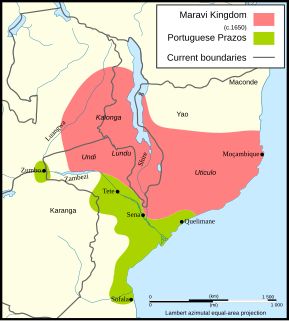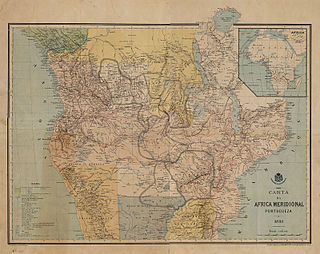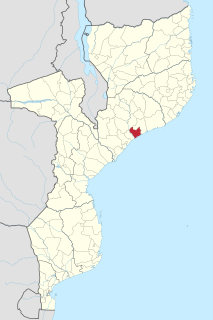Related Research Articles
The History of Malawi covers the area of present-day Malawi. The region was once part of the Maravi Empire. In colonial times, the territory was ruled by the British, under whose control it was known first as British Central Africa and later Nyasaland. It became part of the Federation of Rhodesia and Nyasaland. The country achieved full independence, as Malawi, in 1964. After independence, Malawi was ruled as a one-party state under Hastings Banda until 1994.

Chinde is a town of Mozambique, and a port for the Zambezi valley. It is located on the Chinde River, and is an important fishing center. It exports copra and sugar, and had a population of 16,500 in 1980. Chinde lies in Chinde District of Zambezia Province.

The British Central Africa Protectorate (BCA) was a British protectorate proclaimed in 1889 and ratified in 1891 that occupied the same area as present-day Malawi: it was renamed Nyasaland in 1907. British interest in the area arose from visits made by David Livingstone from 1858 onward during his exploration of the Zambezi area. This encouraged missionary activity that started in the 1860s, undertaken by the Universities' Mission to Central Africa, the Church of Scotland and the Free Church of Scotland, and which was followed by a small number of settlers. The Portuguese government attempted to claim much of the area in which the missionaries and settlers operated, but this was disputed by the British government. To forestall a Portuguese expedition claiming effective occupation, a protectorate was proclaimed, first over the south of this area, then over the whole of it in 1889. After negotiations with the Portuguese and German governments on its boundaries, the protectorate was formally ratified by the British government in May 1891.
This page list topics related to Malawi.

Maravi was a kingdom which straddled the current borders of Malawi, Mozambique, and Zambia, in the 16th century. The present-day name "Maláŵi" is said to derive from the Chewa word "malaŵí", which means "flames".

Alexandre Alberto da Rocha de Serpa Pinto, Viscount of Serpa Pinto was a Portuguese explorer of southern Africa and a colonial administrator.

Nsanje is a district in the Southern Region of Malawi. The capital is Nsanje. The district covers an area of 1,942 square kilometres (750 sq mi) and has a population of 194,924.

The Chewa are a Bantu ethnic group native to central and southern Africa and the largest ethnic group in Malawi. The Chewa are closely related to people in surrounding regions such as the Tumbuka and Nsenga. They are historically also related to the Bemba, with whom they share a similar origin in the Democratic Republic of the Congo. As with the Nsenga and Tumbuka, a small part of Chewa territory came under the influence of the Ngoni, who were of Zulu or Natal/Transvaal origin. An alternative name, often used interchangeably with Chewa, is Nyanja. Their language is called Chichewa. Internationally, the Chewa are mainly known for their masks and their secret societies, called Nyau, as well as their agricultural techniques.

The 1890 British Ultimatum was an ultimatum by the British government delivered on 11 January 1890 to Portugal. The ultimatum forced the retreat of Portuguese military forces from areas which had been claimed by Portugal on the basis of historical discovery and recent exploration, but which the United Kingdom claimed on the basis of effective occupation. Portugal had attempted to claim a large area of land between its colonies of Mozambique and Angola including most of present-day Zimbabwe and Zambia and a large part of Malawi, which had been included in Portugal's "Rose-coloured Map".

The Pink Map, also known in English as the Rose-Coloured Map, was a map prepared in 1885 to represent Portugal's claim of sovereignty over a land corridor connecting their colonies of Angola and Mozambique during the Scramble for Africa. The area claimed included most of what is currently Zimbabwe and large parts of modern Zambia and Malawi. In the first half of the 19th century, Portugal fully controlled only a few coastal towns in Angola and Mozambique. It also claimed suzerainty over other almost independent towns and nominally Portuguese subjects in the Zambezi valley, but could rarely enforce its claims; most of the territory now within Angola and Mozambique was entirely independent of Portuguese control. Between 1840 and 1869, Portugal expanded the area it controlled but felt threatened by the activities of other powers.

Maganja da Costa District is a district of Zambezia Province in Mozambique.

Nyau is a secret society of the Chewa, an ethnic group of the Bantu peoples from Central and Southern Africa. The Nyau society consists of initiated members of the Chewa and Nyanja people, forming the cosmology or indigenous religion of the people. Initiations are separate for men and for women, with different knowledge learned and with different ritual roles in the society according to gender and seniority. Only initiates are considered to be mature and members of the Nyau.
The Mang'anja are a Bantu people of central and southern Africa, particularly around Chikwawa in the Shire River valley of southern Malawi. They speak a dialect of the Nyanja language, and are a branch of the Amaravi people. As of 1996 their population was estimated at 2,486,070.
Eugene Charles Albert Sharrer was a British subject by naturalisation but of German descent, who was a leading entrepreneur in what is now Malawi for around fifteen years between his arrival in 1888 and his departure. He rapidly built-up commercial operations including wholesale and retail trading, considerable holdings of land, cotton and coffee plantations and a fleet of steamers on the Zambezi and Shire rivers. Sharrer was prominent in pressure groups that represented the interests of European planters and their businesses to the colonial authorities, and was responsible for the development of the first railway in what had become the British Central Africa Protectorate, whose construction was agreed in 1902. In 1902, Sharrer consolidate all his business interests into the British Central Africa Company Ltd and became its principal shareholder Shortly after this he left British Central Africa permanently for London, although he retained his financial interests in the territory. Very little is known of his history before he arrived in Central Africa but he died in London during the First World War.
The British Central Africa Company Ltd was one of the four largest European-owned companies that operated in colonial Nyasaland, now Malawi. The company was incorporated in 1902 to acquire the business interests that Eugene Sharrer, an early settler and entrepreneur, had developed in the British Central Africa Protectorate. Sharrer became the majority shareholder of the company on its foundation. The company initially had trading and transport interests, but these were sold by the 1930s. For most of the colonial period, its extensive estates produced cotton, tobacco or tea but the British Central Africa Company Ltd developed the reputation of being a harsh and exploitative landlord whose relations with its tenants were poor. In 1962, shortly before independence, the company sold most of its undeveloped land to the Nyasaland government, but it retained some plantations and two tea factories. It changed its name to The Central Africa Company Ltd and was acquired by the Lonrho group, both in 1964.
The Anglo-Portuguese Treaty of 1891 was an agreement between Great Britain and Portugal which fixed the boundaries between the British Central Africa Protectorate, and the territories administered by the British South Africa Company in Mashonaland and Matabeleland and North-Western Rhodesia and Portuguese Mozambique, and also between the British South Africa Company administered territories of North-Eastern Rhodesia, and Portuguese Angola.
John Buchanan (1855–1896), was a Scottish horticulturist who went to Central Africa, now Malawi, in 1876 as a lay member of the missionary party that established Blantyre Mission. Buchanan came to Central Africa as an ambitious artisan: his character was described as dour and devout but also as restlessly ambitious, and he saw in Central Africa a gateway to personal achievement. He started a mission farm on the site of Zomba, Malawi but was dismissed from the mission in 1881 for brutality. From being a disgraced missionary, Buchanan first became a very influential planter owning, with his brothers, extensive estates in Zomba District. He then achieved the highest position he could in the British administration as Acting British Consul to Central Africa from 1887 to 1891. In that capacity declared a protectorate over the Shire Highlands in 1889 to pre-empt a Portuguese expedition that intended to claim sovereignty over that region. In 1891, the Shire Highlands became part of the British Central Africa Protectorate. John Buchanan died at Chinde in Mozambique in March 1896 on his way to visit Scotland, and his estates were later acquired by the Blantyre and East Africa Ltd.
Chikunda, sometimes rendered as Achikunda, was the name given from the 18th century onwards to the armed retainers of the Afro-Portuguese owners of estates known as Prazos in Zambezia in Mozambique. They were used to defend the prazos and police their inhabitants. The chikunda of that period are often described as slaves, and originally some were chattel slaves, although the status of those that were soldiers, traders or administrators of parts of the prazo was that of a client or unfree dependent.
The Makololo chiefs recognised by the governments of colonial Nyasaland and independent Malawi have their origin in a group of porters that David Livingstone brought from Barotseland in the 1850s to support his first Zambezi expedition that did not return to Barotseland but assisted Livingstone and British missionaries in the area of southern Malawi between 1859 and 1864. After the withdrawal of the Universities' Mission to Central Africa those Makololo remaining in the Shire valley used firearms provided by the Europeans to attract dependants seeking protection, to seize land and to establish a number of chieftainships. At the time that a British protectorate was established in 1891, there were seven Makololo chiefs of which six were recognised by the government. Five survived to be given local governmental powers in 1933, and these powers continued after Malawi became independent. Although called Makololo or Kololo, after the ruling group in Barotseland in the 1850s, the majority came from peoples subject to the Makololo who adopted the more prestigious name. As, regardless of their origin, they took wives from among the inhabitants of the Shire Valley, their modern descendants have little connection with the Kololo people apart from their name.
Jan Mathijs Schoffeleers (1928–2011), who published many of his works in English as Jan Matthew Schoffeleers or Matthew Schoffeleers was a Dutch missionary and member of the Montfort Fathers order who became an important figure in African research as an anthropologist of African religion, particularly that in Malawi, where he spent around 16 years, first as a missionary and then as a lecturer. He continued his academic career later as reader and professor in religious anthropology in the Netherlands, continuing to concentrate on African themes.
References
- ↑ van Binsbergen (2011), pp. 456, 462-3
- ↑ Alpers (1975), pp. 46-9, 53
- ↑ Newitt (1982), pp. 147-8
- ↑ Newitt (1982), pp. 152-3
- ↑ Newitt (1982), pp. 154-5
- ↑ Newitt (1982), pp. 147-9
- ↑ Newitt (1982), p. 157
- ↑ Newitt (1982), pp. 158-9
- ↑ Newitt (1982), p. 159
- ↑ Schoffeleers (1992), p. 127
- ↑ Newitt (1982), p. 160
- ↑ Schoffeleers (1992), p. 42
- ↑ Phiri (1979), p. 9
- ↑ Schoffeleers (1987), p. 339
- ↑ Newitt (1982), pp. 147-8
- ↑ Schoffeleers (1972), pp. 74-5
- ↑ White (1987), pp. 46-7
- ↑ White (1987), p. 60
- ↑ Rangeley (1953), p. 17
- ↑ Schoffeleers (1992), p. 96
- ↑ Schoffeleers (1972), p. 85
- ↑ Schoffeleers (1992), pp. 97-8
- ↑ Schoffeleers (1992), pp. 98-9
- ↑ Schoffeleers (1972), pp. 81-3
- ↑ Rangeley (1953), pp. 9-15
- ↑ Schoffeleers (1972), pp. 169-70
- ↑ Schoffeleers (1992), pp. 117, 121-3, 126
- ↑ Schoffeleers (1980), pp. 247-8
- ↑ Schoffeleers (1992), pp. 8, 117-8
- ↑ Schoffeleers (1980), p. 248.
- ↑ Schoffeleers (1980), p. 250
- ↑ Schoffeleers (1992), pp. 4, 169-70
- ↑ Schoffeleers (1972), p. 73
- ↑ Meyer and Reis (2006), pp. 31-2
- ↑ Schoffeleers (1992), pp. 4, 169-70
- ↑ Wrigley (1988), pp. 369-71
- ↑ Wrigley (1988), pp. 370-1, 2
- ↑ Wrigley (1988), p. 372
- ↑ Rangeley (1952), pp. 32-3
- ↑ Ranger (1973), pp. 582-5
- ↑ Schoffeleers (1988), p. 387-8
- ↑ McCracken (2012), pp. 124-5
- ↑ Schoffeleers (1972), pp. 86-7
- ↑ Schoffeleers (1975), pp. 23-4
- ↑ Schoffeleers (1972), p. 87
- ↑ UNESCO 2011, pp. 1-2
- ↑ Rangeley (1953), pp. 12-14
- ↑ Rangeley (1953), pp. 24-5
- ↑ Schoffeleers (1992), p. 49
- ↑ Schoffeleers (1992), p. 52
- ↑ Rangeley (1953), p. 26
- ↑ Schoffeleers (1992), p. 33-4
- ↑ Schoffeleers (1992), pp. 54, 97
- ↑ Rangeley (1953), pp. 18-9
- ↑ Schoffeleers (1992), pp. 77-8
- ↑ Rangeley (1953), p. 16
- ↑ Schoffeleers (1992), pp. 23, 71-2
- ↑ Schoffeleers (1992), p. 79
- ↑ Schoffeleers (1992), p. 61
- ↑ Schoffeleers (1992), pp. 66-7
- ↑ Rangeley (1952), p. 31
- ↑ Rangeley (1953), pp. 24, 27
- ↑ Rangeley (1953), p. 10
- ↑ McCracken (2012), pp. 224, 320
- ↑ Schoffeleers (1972), p. 86
- ↑ Wrigley (1988), p. 370
- ↑ Rangeley (1953), p. 11
- ↑ Newitt (1995), pp. 280, 282
- ↑ Wrigley (1988), p. 370
- ↑ Schoffeleers (1975), p. 25
- ↑ Schoffeleers (1972), p. 88
- ↑ Schoffeleers (1972), pp. 88-9
- ↑ McCracken (2012), pp. 20-1
- ↑ Newitt (1982), pp. 159-60
- ↑ Schoffeleers (1972), pp. 74-5
- ↑ Ranger (1973), p. 582
- ↑ Ranger (1973), pp. 582-3
- ↑ Ranger (1973), p. 594
- ↑ Ranger (1973), pp. 584-6
- ↑ Ranger (1973), pp. 586-7
- ↑ Ranger (1973), pp. 591-2
- ↑ Ranger (1973), pp. 587-8
- ↑ Ranger (1973), pp. 587-8
- ↑ Schoffeleers (1972), pp. 78-9
- ↑ Schoffeleers (1992), p. 12
- ↑ Schoffeleers (1992), pp. 175-6
Sources
- E. A. Alpers, (1975). Ivory and Slaves in East Central Africa; changing patterns of international trade to the later nineteenth century. London, Heinemann. ISBN 978-0-43532-005-8.
- W. M. J. van Binsbergen (2011). In Memoriam: Matthew Schoffeleers (1928-2011). Journal of Religion in Africa, Vol. 41, No. 4, pp. 455–463
- J McCracken, (2012). A History of Malawi, 1859–1966, Woodbridge, James Currey. ISBN 978-1-84701-050-6.
- B. Meyer and R. Reis, (2006) Matthew Schoffeleers: Anthropologist and Priest. Etnofoor, Vol. 18, No. 2, pp. 23–46
- M. D. D. Newitt, (1982). The Early History of the Maravi, Journal of African History, Vol. 23, No. 3, pp. 145–162
- M. D. D. Newitt, (1995). A History of Mozambique, London, Hurst & Co, pp 276–7, 325-6. ISBN 1-85065-172-8
- K. M. Phiri, (1979). Northern Zambezia: From 1500 to 1800. The Society of Malawi Journal, Vol. 32, No. 1, pp. 6–22
- W.H.J. Rangeley, (1952) Makewana - The Mother of All People, Nyasaland Journal, Vol. 5, No. 2 (1952), pp. 31–50.
- W. H. J. Rangeley, (1953). M'Bona the Rainmaker, Nyasaland Journal, Vol. 6, No, 1 pp. 8–27.
- T. Ranger, (1973) Territorial Cults in the History of Central Africa, The Journal of African History, Vol. 14, No. 4, pp. 581–597
- M. Schoffeleers, (1972). The History and Political Role of the M'Bona Cult among the Mang'anja in T. O. Ranger and I. N. Kimambo (editors), The Historical Study of African Religion. Berkeley, University of California Press. ISBN 0-52003-179-2.
- M. Schoffeleers, (1975). The Interaction of the M'Bona Cult and Christianity in T. O. Ranger and J. C. Weller (editors), Themes in the Christian History of Central Africa. Berkeley, University of California Press. ISBN 0-52002-536-9.
- M. Schoffeleers, (1980). The Story of Mbona the Martyr in R. Schefold, J. W. Schoorl and J. Tennekes (editors), Man, Meaning and History: Essays in Honour of H.G. Schulte Nordholt. Leiden, Brill. ISBN 978-9-02472-382-9.
- M. Schoffeleers, (1987). The Zimba and the Lundu State in the Late Sixteenth and Early Seventeenth Centuries. The Journal of African History, Vol. 28, No. 3, pp. 337–355
- M. Schoffeleers, (1988). Myth and/or History: A Reply to Christopher Wrigley. The Journal of African History, Vol. 29, No. 3, pp. 385–390.
- J. M. Schoffeleers, (1992). River of Blood: The Genesis of a Martyr Cult in Southern Malawi, c. A.D. 1600. Madison, University of Wisconsin Press. ISBN 0-29913-324-9.
- UNESCO, (2011). Khulubvi and Associated Mbona Sacred Rain Shrines, Tentative List of properties for nomination as World Heritage Sites (File WHTL 5602). https://whc.unesco.org/en/tentativelists/5602/
- C. Wrigley, (1988). The River-God and the Historians: Myth in the Shire Valley and Elsewhere. The Journal of African History, Vol. 29, No. 3, pp. 367–383